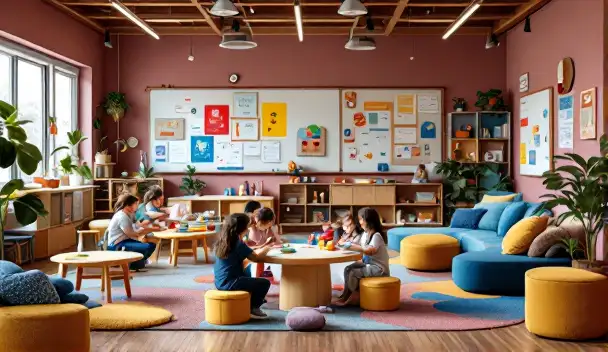Transforming Lives with Evidence-Based Strategies
Applied Behavior Analysis (ABA) offers a scientifically grounded approach to teaching essential daily living skills to individuals with autism. By implementing systematic techniques such as task analysis, chaining, prompt fading, and reinforcement, ABA creates personalized learning paths that foster independence, self-confidence, and improved quality of life. This article explores how these methods are used effectively across various environments, emphasizing the importance of caregiver involvement, naturalistic teaching, and data-driven decision making.
Understanding How ABA Supports Daily Living Skills Development

How does ABA therapy help in teaching daily living skills to individuals with autism?
ABA (Applied Behavior Analysis) therapy is a structured, evidence-based approach that plays a vital role in helping individuals with autism acquire essential daily living skills. Therapists utilize methods such as task analysis, chaining, prompting, and reinforcement to teach complex skills in manageable steps. By breaking down tasks like dressing, grooming, cooking, and personal hygiene into smaller, achievable parts, individuals can learn with clarity and confidence.
Visual supports, social stories, and modeling are frequently used to enhance understanding. These tools help individuals grasp routines and expectations, making learning more accessible. For example, a visual schedule might demonstrate the sequence of brushing teeth or preparing a simple meal.
Therapists tailor interventions to each learner’s unique needs, interests, and abilities. Practice occurs in real-world contexts—such as at home, school, or community settings—using Natural Environment Teaching (NET). This methodology encourages the generalization of skills beyond the therapy setting.
Caregivers and family members are active partners in the process. They receive training from ABA professionals to reinforce skills consistently and support ongoing development. This collaboration ensures that learned behaviors translate into everyday life, promoting independence.
Overall, ABA therapy significantly boosts daily living capabilities, fostering independence and enhancing overall quality of life for individuals with autism.
Core Techniques for Teaching Daily Life Skills Using ABA
What are some effective ABA techniques for teaching daily living skills?
Applied Behavior Analysis (ABA) utilizes a variety of strategies proven to be effective for teaching essential daily living skills. Central to these methods is breaking down complex activities into smaller, manageable parts through task analysis. This process involves listing each step required to complete a task, such as brushing teeth or getting dressed, which makes learning more approachable.
Chaining methods—forward, backward, and total chaining—are also employed to teach sequences of behaviors. For example, forward chaining prompts the learner to complete the first step independently, then gradually adds subsequent steps. Backward chaining starts with the last step, providing reinforcement once the entire sequence is completed successfully. Total chaining involves guiding the learner through every step each time, offering continuous support.
Prompting and prompt fading are used to initiate and gradually reduce assistance, helping learners gain independence. Initially, prompts like gestures, modeling, or physical assistance guide behavior. Over time, prompts are faded to encourage the learner to perform skills with less support.
Visual supports, such as visual schedules, cue cards, and picture exchange communication systems, aid understanding and recall. These tools clarify expectations and help structure routines, making tasks predictable and less overwhelming.
Natural Environment Teaching (NET) integrates learning with real-life contexts, like home, school, or community settings. This approach encourages learners to apply skills functionally in environments where they naturally occur, leading to better generalization.
Reinforcement plays a vital role in ABA. By providing immediate, individualized rewards—such as praise, tokens, or preferred items—desired behaviors are strengthened and more likely to be repeated.
Ongoing data collection and progress monitoring are essential for tailoring interventions. ABA therapists track each learner’s response to strategies, adjusting techniques and reinforcement schedules as needed.
These ABA techniques collaboratively foster development in areas such as self-care, household chores, safety, and community participation, ultimately leading to greater independence and improved quality of life.
| Technique | Purpose | Implementation Example | Additional Details |
|---|---|---|---|
| Task analysis | Break skills into steps | Listing steps for brushing teeth | Foundation for chaining |
| Chaining | Teach sequential behaviors | Teaching cooking skills step-by-step | Tailored to the learner's needs |
| Prompting & fading | Support and reduce assistance over time | Hand-over-hand to independence | Ensures gradual skill acquisition |
| Visual supports | Clarify routines and expectations | Using picture schedules for mealtime | Enhances comprehension and memory |
| Natural Environment Teaching | Promote real-world application | Shopping or playing in community settings | Encourages generalization |
| Reinforcement | Strengthen desired behaviors | Praising for completing a task | Based on individual preferences |
By combining these strategies within a personalized plan, ABA therapy effectively enhances daily living skills, empowering individuals with autism to be more self-reliant and confident in their daily routines.
Examples of Daily Living Skills Addressed in ABA Therapy
What are some examples of daily living skills that can be taught to individuals with autism?
ABA therapy is highly effective in teaching a wide array of daily living skills that enhance independence and improve quality of life. These skills range from basic personal hygiene to household management and community navigation.
Among personal hygiene tasks, individuals are taught how to brush their teeth, shower properly, and care for their hair. These activities often involve detailed task analysis, where each step is broken down and supported with visual cues and prompts.
Self-care activities extend to dressing appropriately, grooming, and nail care. These are essential for personal comfort and social acceptance, and teaching them promotes self-confidence.
Household chores are also covered extensively within ABA programs. Skills such as cleaning, making beds, organizing belongings, and tidying up are taught through repetitive practice and reinforcement. These routines help develop responsibility and organizational skills.
Cooking and managing household tasks, including preparing simple meals, washing dishes, and doing laundry, are learned using structured, step-by-step instructions. Visual supports like picture schedules and task sequences facilitate mastery.
Safety skills are crucial for autonomy, and ABA therapy addresses them thoroughly. These include understanding how to cross streets safely, recognize community hazards, navigate public transportation, and seek help when needed.
Teaching these skills involves versatile ABA techniques like chaining, prompting, reinforcement, and generalization strategies to ensure skills are transferred across different settings and situations.
Early intervention programs target these foundational skills, setting the stage for better independence and improved self-esteem.
Below is a summary of some common daily living skills taught in ABA therapy:
| Skill Area | Examples | Teaching Strategies |
|---|---|---|
| Personal Hygiene | Brushing teeth, bathing, hair care | Task analysis, visual supports, reinforcement |
| Self-care | Dressing, grooming, nail care | Prompt fading, modeling, reinforcement |
| Household chores | Cleaning, organizing, laundry | Chaining, visual schedules, step-by-step instructions |
| Cooking & Meal Prep | Preparing simple meals, safety in kitchen | Visual supports, practice with supervision |
| Safety Skills | Crosswalks, community awareness, emergency procedures | Role-playing, safety drills, warning signs |
In summary, ABA therapy individualizes teaching plans to address essential daily living skills. By breaking tasks into manageable parts and systematically reinforcing progress, individuals with autism can develop the independence needed for successful community and household participation.
Strategies for Teaching Life Skills in Natural Settings

What strategies are effective in teaching daily living skills to children with autism?
Teaching children with autism essential daily living skills requires a combination of structured, evidence-based strategies tailored to their unique learning needs. Visual supports are fundamental tools in this process. Picture schedules, social stories, and visual cues help children understand routines and expectations, making tasks more manageable and predictable.
Breaking down complex tasks into manageable segments is achieved through task analysis. This involves outlining each step of a skill, such as brushing teeth or washing hands, to facilitate focused teaching. Chaining procedures, whether forward, backward, or total, further reinforce these steps, ensuring skills are learned sequentially and thoroughly.
Naturalistic teaching methods play a significant role by integrating learning into everyday environments. Techniques like observation, imitation, and engaging in scenario-based activities, such as 'What Would You Do?', foster real-life application and generalization of skills across different settings.
Prompting strategies, combined with prompt fading, support children through initial learning phases while encouraging independence over time. Reinforcement, especially positive reinforcement, solidifies desired behaviors and motivates continued practice.
In addition to task-specific interventions, self-management tools like pictorial self-monitoring and emotion cards can help children regulate emotions and behaviors.
Collaboration among therapists, educators, and families is essential. Consistent routines at home and school, alongside a supportive environment, reinforce learning and promote independence. These methods collectively enable children with autism to acquire vital life skills that enhance their daily functioning and overall quality of life.
Creating Effective Plans for Teaching Daily Living Skills

How can I create a checklist or plan for teaching daily living skills?
Developing a structured plan for teaching daily living skills is crucial for fostering independence. Begin by breaking down each skill into small, manageable steps tailored to the individual's current abilities, age, and needs. For example, teaching brushing teeth can involve steps like grabbing the toothbrush, applying toothpaste, brushing, rinsing, and storing the toothbrush.
Use established resources and checklists from reputable sources, such as occupational therapy guides or transition planning tools. These resources often include comprehensive lists covering self-care, household chores, communication, and community navigation.
Incorporate visual supports like pictures, schedules, and step-by-step guides to make the learning process clearer. Visual aids help individuals generalize skills across settings and reinforce understanding.
A detailed plan should also include space for tracking progress. Record dates, assistance levels, and notes on mastery or challenges. This helps in adjusting teaching strategies and celebrating milestones.
Personalization is vital. Focus on specific, practical goals that relate to the individual’s daily routines and interests. Use gradual learning approaches, starting with simple tasks and increasing complexity as skills develop.
Utilize tools such as downloadable PDFs, checklists, and assessment instruments like the Katz Index for structured evaluation. These tools help monitor progress in Activities of Daily Living (ADLs) like grooming and dressing, and Instrumental Activities (IADLs) like cooking or managing money.
Creating a personalized, visual, and measurable plan enhances the effectiveness of teaching daily living skills, leading to increased independence and confidence.
Setting Goals and Measuring Progress in ABA Interventions

What are common goals and objectives for teaching daily living skills in individuals with autism?
In ABA therapy, the primary focus is on helping individuals develop essential skills that promote independence and improve quality of life. Typical goals include teaching self-care tasks such as dressing, grooming, toileting, and maintaining personal hygiene.
Beyond personal hygiene, goals extend to household management—like washing dishes, cooking simple meals, cleaning, and managing laundry. Skills related to community navigation, such as using public transportation, shopping, and understanding safety protocols, are also emphasized.
These objectives are tailored to each person’s age, needs, and interests, aiming to enhance confidence and self-esteem. Achieving these skills enables individuals to participate actively in their home, school, and community environments.
Strategies for reaching these goals involve structured techniques like task analysis, breaking tasks into smaller steps, and deploying visual supports such as checklists and schedules. Natural Environment Teaching (NET) and positive reinforcement are used to make learning relevant and enjoyable.
Implementing consistent practice across different settings ensures that skills are generalized and maintained over time. Caregiver involvement, including modeling and reinforcement, plays a crucial role in this process.
The overarching purpose of these goals is to foster safe, autonomous, and meaningful participation in daily life activities, equipping individuals with autism to lead more independent and fulfilling lives.
Applying ABA Principles to Enhance Daily Functioning

How can ABA principles be applied to improve everyday life and skills?
Applied Behavior Analysis (ABA) offers practical strategies to help individuals develop essential daily skills and improve behavior across various environments. Central to ABA is the detailed analysis of behavior, where therapists look at what happens before a behavior (antecedents), the behavior itself, and what follows after (consequences). This understanding helps in designing effective interventions.
One of the primary techniques used in ABA is positive reinforcement. This involves offering a valued reward immediately after a desired behavior, encouraging its repetition. For example, a child might receive praise or a small treat for completing a task independently. Reinforcement can be tailored to individual preferences, making learning motivating and effective.
Task analysis is another vital method. It breaks down complex daily activities, like brushing teeth or making a meal, into smaller, manageable steps. Visual supports, such as picture schedules or step-by-step cards, assist individuals in understanding and completing each part of the task. Prompting and prompt fading are used to guide individuals initially, gradually reducing help as independence grows.
Creating a supportive environment is essential. Clear routines, visual cues, and consistent expectations help individuals understand what's expected of them. This consistency promotes the generalization of skills across different settings—home, school, or community—ensuring skills are used adaptively.
Environmental modifications also play a role. Adjustments like minimizing distractions or organizing materials make tasks easier and more accessible. These changes support improved focus and task completion.
Involving caregivers is crucial. They are trained to use ABA strategies at home, model desired behaviors, and reinforce progress. Regular monitoring and data collection allow therapists to track improvements and make necessary adjustments.
Overall, applying ABA principles systematically enhances everyday functioning. It builds independence, fosters positive behaviors, and helps individuals participate more fully in their daily lives.
The Path Towards Greater Independence
ABA therapy stands as a cornerstone in equipping individuals with autism to master daily living skills essential for autonomous and meaningful living. Its evidence-based strategies—tailored to each person’s strengths and needs—build a foundation for lifelong independence. By integrating techniques like task analysis, chaining, prompting, and reinforcement across natural and familiar settings, ABA ensures these skills become ingrained and functional. The active involvement of caregivers and close collaboration with professionals further strengthens generalization, ensuring these vital skills translate beyond the therapy sessions into everyday life. As research continues to validate its effectiveness, ABA remains a powerful approach, fostering confidence and unlocking potential for individuals with autism.
References
- How ABA Therapy Helps with Daily Living Skills
- Applied Behavior Analysis (ABA) | Autism Speaks
- Teaching daily living skills to children with autism in unsupervised ...
- How ABA Therapy Helps Build Daily Living Skills | Dream Big
- 10 Ways ABA Therapy Can Help with Life Skills
- Chaining to Build Daily Living Skills at Fast Track ABA
- Boosting Independence: Self-Care and Daily Living Skills Through ...
- How ABA Therapy Helps with Daily Living Skills
- 11 Tips for Teaching Activities of Daily Living - Regis College Online
- How ABA Therapy Helps Build Daily Living Skills | Dream Big












